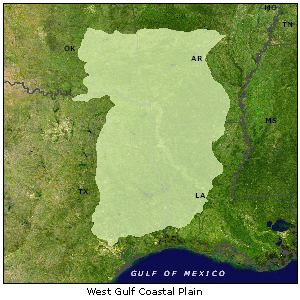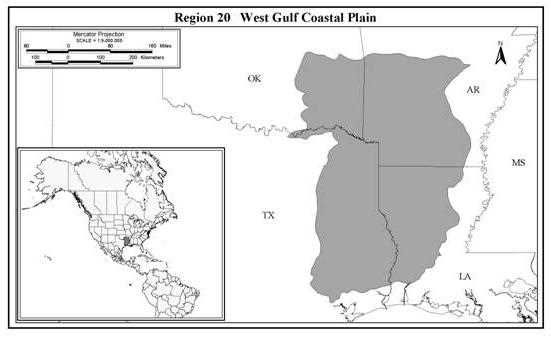Level III Ducks Unlimited conservation priority area, wintering more than 1 million diving ducks in some years

The West Gulf Coastal Plain is comprised of more than 52 million acres in three sub-regions: the West Gulf Coastal Plain, the Ouachita Mountains and the Arkansas River Valley. Bottomland forests and associated wetlands support substantial populations of wintering waterfowl as well as breeding and wintering wood ducks. The forested wetlands are similar to those found to the east in the Mississippi Alluvial Valley. They tend to flood seasonally, though reservoir construction on all of the rivers has negatively impacted their hydrology and generally reduced seasonal flooding and value to waterfowl in many years.

Arkansas | Louisiana | Oklahoma | Texas

The West Gulf Coastal Plain Bird Conservation Region (Region 20*) encompasses southeastern Oklahoma, northeastern Texas, southwestern Arkansas, and northwestern Louisiana. The Mississippi Alluvial Valley (MAV) and the Gulf Coastal Prairies are the eastern and southern borders of the WGCP conservation region, respectively. For the purposes of conservation planning for waterfowl, the WGCP has been incorporated into the Lower Mississippi Valley Joint Venture focus area of the NAWMP (Loesch et al. 1994).
Uplands throughout the region are dominated by shortleaf pine in the northern two-thirds of the region, while longleaf pine dominates the southern one-third. Bottomland hardwood forested wetlands occur in the WGCP in association with major and minor river bottoms. Major rivers that have significant bottomland hardwood habitat associated with them include the Arkansas, Red, Sabine, Angelina, and Trinity.
Forested wetlands are similar in plant species composition to those found to the east in the MAV. They tend to flood seasonally, though reservoir construction on all of the rivers has negatively impacted their hydrology and generally reduced seasonal flooding and value to waterfowl in many years. Forested wetlands along the Arkansas and Red Rivers in particular have been converted to agriculture. Indiscriminate logging and subsequent conversion to pine timber production or pasture threaten remaining forested wetlands, particularly in eastern Texas. Also, increasing demands for water in the Dallas-Fort Worth metropolitan area has resulted in construction of numerous water supply reservoirs. Additional reservoirs have been proposed that would destroy additional forested wetlands. Hence, reservoir construction has caused loss of substantial forested wetland habitat and remains a threat so long as water supply needs for Dallas-Fort Worth, Houston, and other principal cities in eastern Texas increase.
The Lower Mississippi Valley Joint Venture (LMVJV) has set winter population objectives of 3.3 million ducks for the WGCP portion of this focus area (Loesch et al. 1994). These objectives do not include portions of Arkansas and Louisiana that are in the MAV proper. Approximately 44% of this objective consists of dabbling ducks, with mallards, gadwall and wigeon being the most common species in winter (Loesch et al. 1994). In some winters, up to 1.15 million diving ducks occur and make extensive use of aquatic vegetation in large reservoirs in the region. Ring-necked ducks, lesser scaup, and canvasbacks are the most common diving duck species. The population objective for wood ducks in the WGCP is 808,000. Wood ducks use naturally flooded forested wetlands extensively in the WGCP. An undetermined but likely sizeable and significant number of wood ducks breed in forested wetlands of this conservation region. Use of this region by wintering and migrating geese is insignificant relative to adjacent bird conservation regions like the MAV and Gulf Coastal Prairies.
The LMVJV West Gulf Coastal Plain Waterfowl Working Group established revised population goals and associated population-based foraging habitat objectives for dabbling ducks in 2005. Based upon that exercise, it is estimated that there is a dabbling duck foraging habitat shortfall of approximately 12,854 ha in the WGCP under average winter conditions. It should be noted that this analysis does not account for foraging habitat provided through the Wetland Reserve Program. Hence, in years of average to above average fall and winter precipitation, foraging habitat shortfalls likely are not a significant factor in limiting the regional population of wintering waterfowl. Wood ducks are assumed to use naturally flooded forested wetlands. The amount of naturally flooded forested wetlands is highly variable in the region, but no estimates are available in regard to potential shortfalls or surpluses of habitat. Diving duck habitat also has not been quantified for the WGCP.
*Region 20 - NABCI Bird Conservation Region 25
The pine-dominated uplands that comprise the majority of this region are home to numerous colonies of red-cockaded woodpeckers. In addition, pine uplands are important habitat for Bachman's sparrows and brown-headed nuthatches. Riverine habitats, particularly sandbars, likely were important nesting habitat for interior least terns and provided some shorebird habitat. Most of the major rivers have been altered via reservoir construction or navigation projects and most sandbar habitat is no longer present. Bottomland hardwood wetlands along major rivers are important habitat for several species of colonial wading birds, and for neotropical migrant passerines, particularly Swainson's warblers.
DU conservation programs have grown considerably in each of the four states in the WGCP. Substantial restoration work has been completed through the Wetland Reserve Program, and through traditional private and public lands conservation programs in all four states. Through FY2004, DU has worked with multiple partners to conserve 27,790 ha in the WGCP conservation region. The estimated dabbing duck foraging habitat shortfall will be met within a 5-10 years through restoration activities associated with WRP, private lands conservation programs, and on public lands in cooperation with state and federal agencies.
The primary goal of conservation programs in the WGCP is to protect, restore, enhance and manage waterfowl and wetland habitat consistent with the objectives of the LMVJV of the NAWMP. Specific goals include:
Ducks Unlimited uses cookies to enhance your browsing experience, optimize site functionality, analyze traffic, and deliver personalized advertising through third parties. By continuing to use this site, you agree to our use of cookies. View Privacy Policy